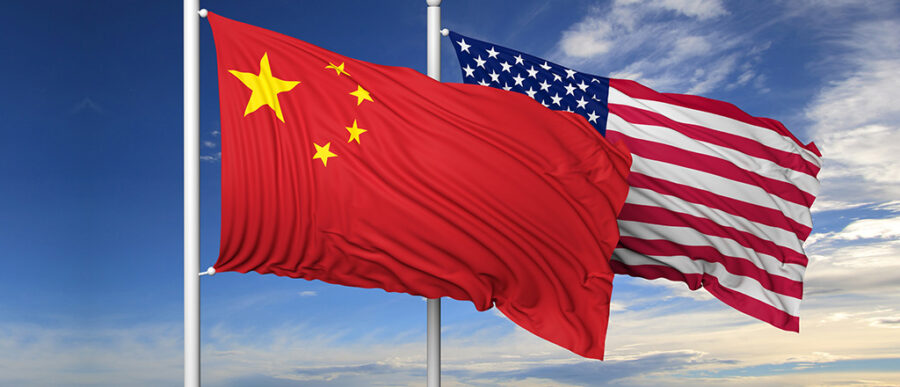The U.S.’s move to slap tariffs on up to $60 billion worth of imports from China could escalate into a trade war in which there will be no winners, according to experts at Wharton and elsewhere. The U.S. decision drew a swift reaction with China on Friday announcing tariffs on some $3 billion worth of imports from the U.S.
Financial markets tumbled, but recovered somewhat in later trading after signs that the U.S. and China could hammer out a negotiated settlement. The Wall Street Journal reported Monday that China’s newly appointed vice premier and economic czar Liu He, U.S. Treasury Secretary Steven Mnuchin and U.S. Trade Representative Robert Lighthizer are leading the talks. The U.S. side is asking China to cut tariffs on American automobiles and buy more U.S. semiconductors, among other demands, the report said, adding that Mnuchin may soon visit China.
Notwithstanding the willingness of both countries to negotiate a way out of the trade disputes, the potential downsides of confrontation are apparent. “Ouch, this hurts,” said Marshall Meyer, Wharton emeritus professor of management and a longtime China expert, on his initial reaction to the U.S. tariffs. However, he said he wasn’t surprised at the U.S. action. “I’m a little concerned that we’re using a blunt instrument rather than a fine scalpel.”
China has responded by talking tough, and has “left the door open saying [that it has] retaliatory measures ready to go,” according to Jacques deLisle, professor of law and political science at the University of Pennsylvania, who is also director of the Penn’s Center for East Asian Studies. That includes action that could hurt U.S. agricultural exports and maybe also “areas that are important to Trump’s base,” he added. He read China’s responses to mean that it is prepared to fight a trade war and win it, but [prefers to] negotiate and find a way out.”
“Ouch, this hurts. I’m a little concerned that we’re using a blunt instrument rather than a fine scalpel.” –Marshall Meyer
According to Matt Gold, an adjunct professor of law at Fordham University and a former deputy assistant U.S. trade representative for North America, the U.S. is “not free to react to this in an impulsive way … that is quick and will bring quick results.” He noted that former U.S. presidents have chosen not to pursue that path for good reason.
Meyer, deLisle and Gold weighed the implications of the U.S. actions against China on the Knowledge at Wharton show on SiriusXM channel 111. (Listen to the full podcast using the player at the top of this page.)
Rhetoric and Measured Options
Trump clearly indicated that he was just beginning to go after China for alleged trade discrimination. “It could be about $60 billion [of imports from China] but that’s really just a fraction of what we’re talking about,” he said at the signing of a memorandum on March 22 as he announced the tariffs. There is sufficient reason for the U.S. to be exercised. China alone accounted for $375 billion of the U.S. trade deficit in goods of $811 billion, Lighthizer told the Senate Finance Committee earlier that day.
Lighthizer’s office will publish a list of targeted products in the next two weeks with a 30-day public comment period. The Chinese products that will be subject to the new tariffs include aeronautics, modern rail, new-energy vehicles and high-tech products from among a list of some 1,300 product lines, CNBC reported.
Issues on the Table
According to deLisle, the Trump administration’s policy on this subject has to deal with three aspects. One is to launch a WTO complaint about “coerced transfers,” or China’s act of coercing intellectual property transfers by U.S. firms operating in that country. The Trump administration has shown little patience to go through a WTO process to address that, he noted. The second aspect is Trump administration’s response to China’s alleged trade agreement violations with import tariffs, he said. The third aspect relates to restricting Chinese foreign investment in the U.S., but deLisle said processes already exist to address that problem, such as an inter-agency review process through the Committee on Foreign Investment in the U.S.
“Intellectual property is obviously the sector in which the U.S. has the greatest comparative advantage and there’s been a lot of problems with Chinese theft, weak protection and hard bargaining for tech transfer,” said deLisle. Gold agreed: “China has heinously stolen U.S. intellectual property rights and violated other trade obligations to the U.S.”
Meyer noted that the tariffs, at least originally, were directed at “smokestack industries” where China is already shutting down capacity and is therefore not expected to resist a great deal. At the same time, he said that he wasn’t sure if the Trump administration’s actions address the “underlying problems” concerning trade with China.
Two Paths
Gold said a central piece of the debate is that two ways exist for the U.S. to retaliate against another country for violating trade treaty obligations: “One is legal. One is not.” The legal route involves raising a complaint at the World Trade Organization, which would mean litigation to prove to a WTO panel that the other country violated a trade agreement, followed by a similar process at an appellate body, he explained. If the charge is proved, the other country would then be given a chance to comply with the rules, and then if it fails to comply, the appellate body would approve specific retaliation, all of which would take about four years, he added.
Not following that WTO process “seriously risks pushing everyone into a trade war and a seriously dangerous downward spiral,” said Gold. Trump’s memorandum on the tariffs gives the U.S. trade representative that option of pursuing the four-year process, even if his rhetoric didn’t indicate that, he added.
“Intellectual property is the sector in which the U.S. has the greatest comparative advantage and there’s been a lot of problems with Chinese theft, weak protection and hard bargaining for tech transfer.”— Jacques deLisle
On the other hand, “if Trump and the U.S. trade representative go ahead and just impose sanctions now or in the near future without WTO approval, then we’re looking at a real train wreck,” Gold said. Trump is no fan of the WTO. “The WTO … has been great for China and terrible for the United States, and great for other countries,” he had said when he announced the tariffs on steel and aluminum.
Experts had called for a negotiated solution also when Lighthizer’s office in January announced import tariffs on Chinese residential washing machines and solar panels. Earlier this month, Trump announced import tariffs of 25% on steel and 10% on aluminum, stoking fears of retaliatory action from China, Canada and Brazil.
How the Pullout from the TPP Hurt
According to Meyer, the U.S. essentially gave away its best tools to bargain with China when it pulled out of the Trans-Pacific Partnership (TPP) in January 2017. Added deLisle: “Opting out of the TPP was one problem; threatening to opt out of the WTO, being critical of Nafta (the North American Free Trade Agreement), being critical of the Korea-U.S. free trade agreements — taking on all of that was not a great idea.”
Trump did not follow up on those moves by lining up support from other countries that have complaints against China that are similar to the U.S., he said. “Instead of that, Trump’s been busy sticking a thumb in the eye of all those folks and then comes in with this [latest tariff plan]. It’s not really the best way to get maximum leverage against China.”
In any event, Lighthizer had told the Senate Finance Committee of the Trump administration’s plans to pursue free trade agreements with the U.K. when it is free from the European Union, Japan and countries in Africa and Asia.
“The single greatest gift the U.S. has ever given China is Trump throwing away U.S. participation in the Trans-Pacific Partnership, and it’s also a massive gift to Russia,” said Gold. Had the U.S. stayed in the TPP, “we would have had just astounding leverage over China,” he added. Gold noted that he had managed the process by which Canada and Mexico joined the TPP in his previous role as a deputy assistant U.S. trade representative for North America.
Understanding China
According to Meyer, many policy makers “don’t understand what we’re dealing with” because “China is intensely capitalistic and intensely competitive, especially within firms.” Its firms have the incentives “to work hard and produce at low cost, albeit aided and abetted by a little borrowing of IP,” he added.
“If Trump and the U.S. Trade Representative go ahead and just impose sanctions [on China] now or in the near future without WTO approval, then we’re looking at a real train wreck.” –Matt Gold
Gold noted that China has an “enormous government,” and that coming into full compliance with WTO obligations requires “a large corporate culture change.” He acknowledged that China’s progress in complying with WTO obligations has been “slow and frustrating,” but noted that “it never moved backward with them.”
Now, if the Trump administration wants to take retaliatory action with import tariffs, it will backfire on three fronts, he said. One, it would hurt the U.S. economy, Gold said. Second, it’s not clear if China could respond with attempts at compliance in the way the U.S. wants it to, even if it tried, because of the “corporate culture problem” within its government. Third, “it will do great damage to the Chinese economy and [that would become] a national security problem for the U.S.,” he warned. “If a centrally planned economy that large collapses, that’s a global security train wreck,” he said.
Given that prediction, “engagement is a better move than confrontation,” said Gold. “But if Trump is going to go the way of confrontation, I wouldn’t say it’s necessarily a mistake as long as he follows the WTO process. [However], it’s definitely a huge mistake if he doesn’t.”
Meyer, who recently visited Israel, talked of how in that country, perceptions about China vary across generations. The older generation in Israel is wary of China because the latter votes against it in the United Nations, he said.
“The younger folks, however, are looking at these entreaties from China: ‘Israel, come be part of the One Belt, One Road project — you occupy this strategic position joining two continents. We’ll help you build a railroad from Eilat on the Red Sea up to the Mediterranean, and another path — China into Europe,’” he said. “Quite frankly, the younger folks find this very attractive. So until and unless we bring our partners together, we’re going to wake up one morning and find that China has worked out trade relationships with the whole Eurasian continent, much of Africa, and we’re sitting there isolated.”



